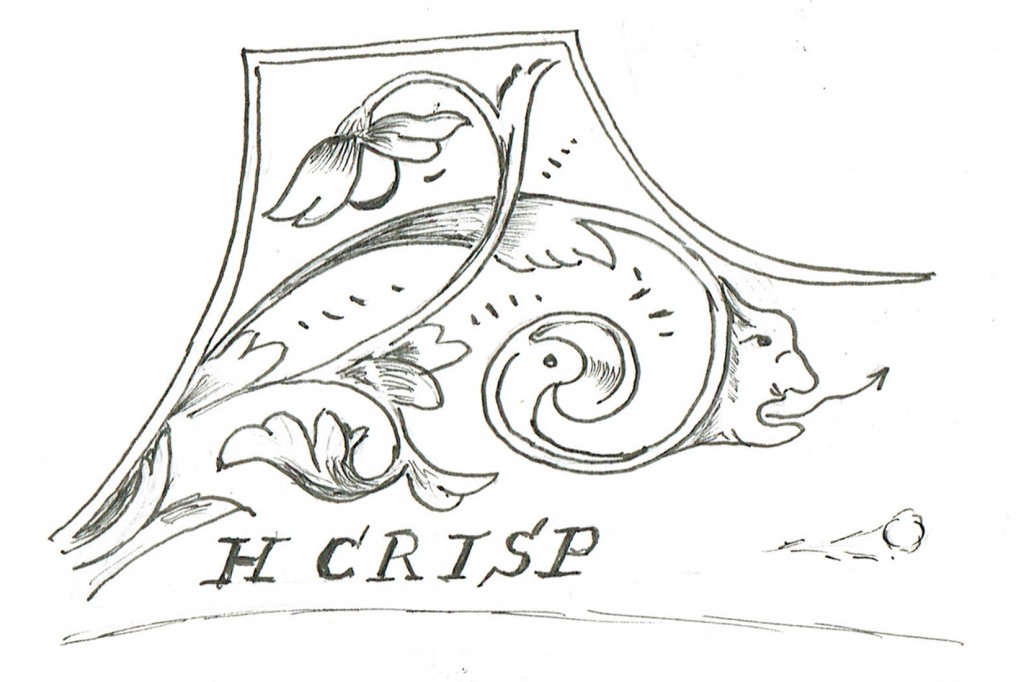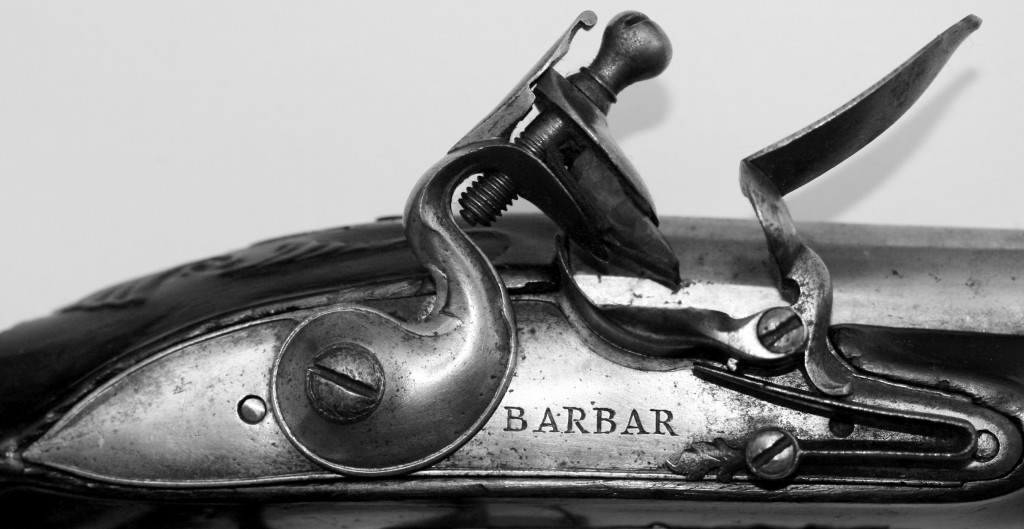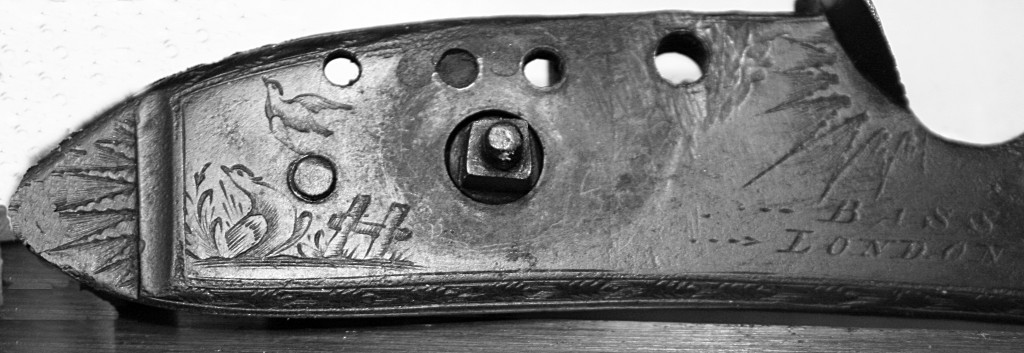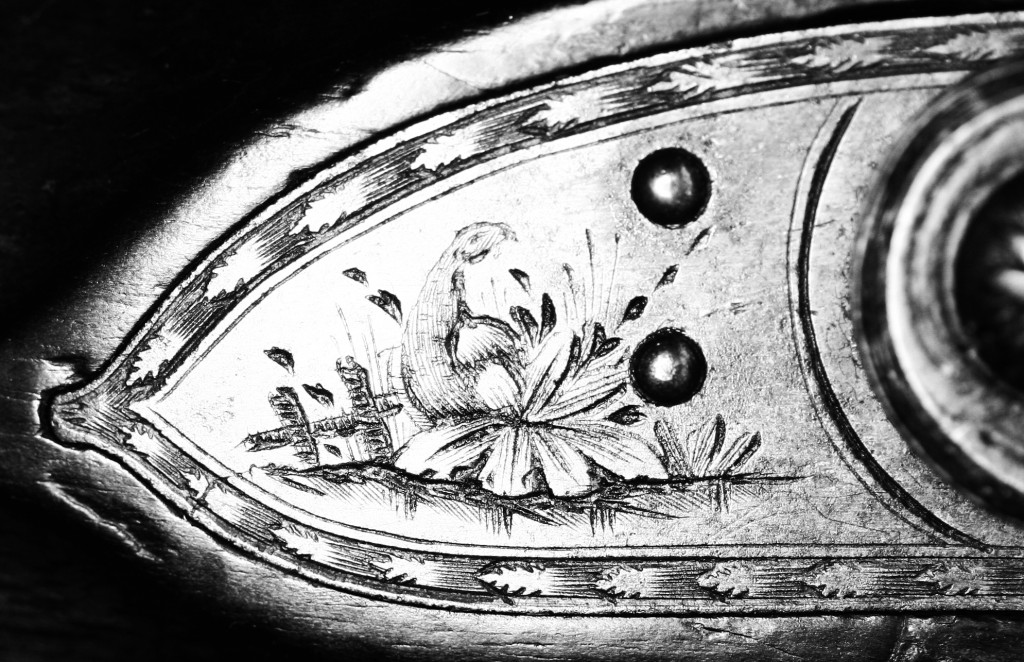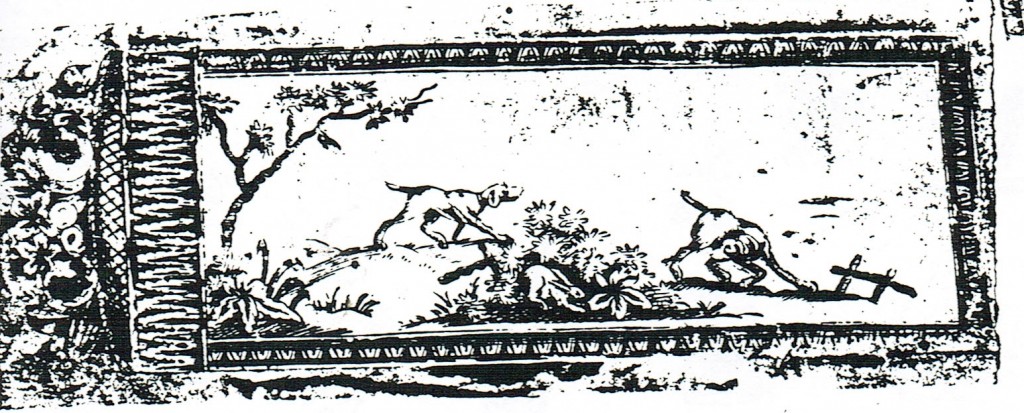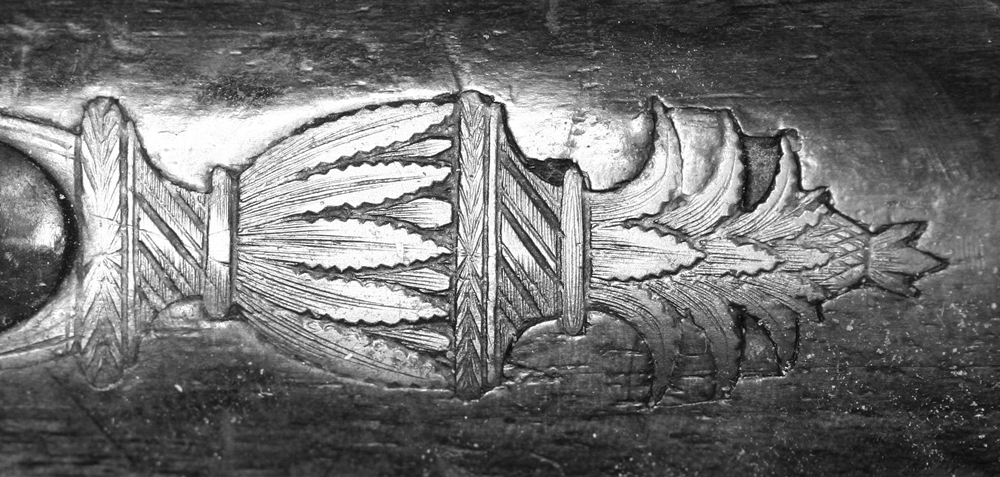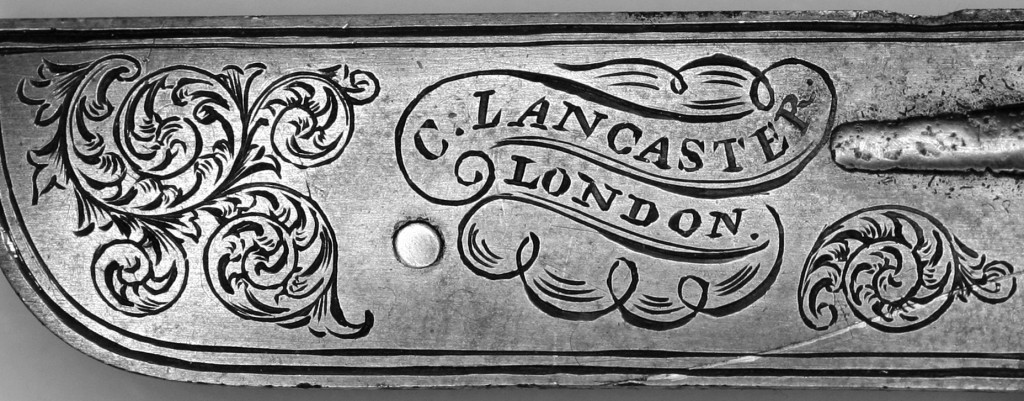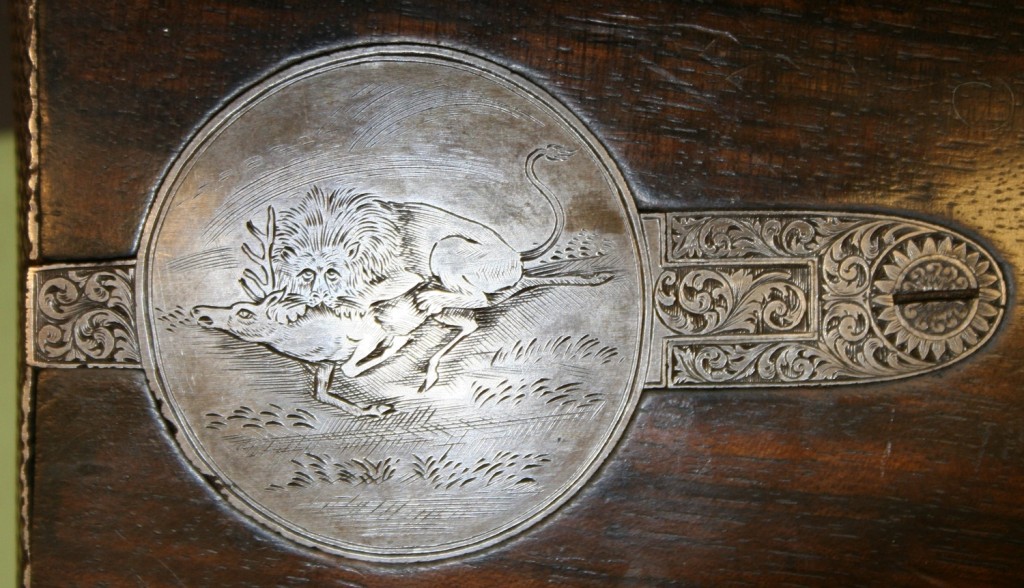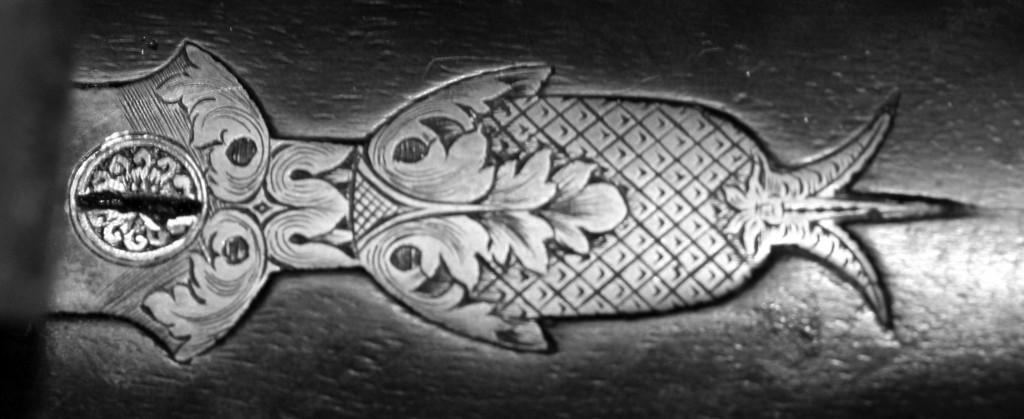A Beginners’ Guide to
Collecting and Restoration
Part 4: Style and Engraving of English Flintlock and Percussion Guns.
By Tim Owen
First published in the Summer edition of Black Powder, the magazine of the Muzzle Loading Association of Great Britain.
The very early history of firearms is dominated by their use for military purposes, and their appearance was secondary to their function role. It was not long, however, before civilian uses for firearms became significant and since only the rich could afford to own them, they became a vehicle for the display of wealth and taste in addition to their functional role in sport or personal protection. In some cases firearms lost their functional role almost completely and were purely for presentation. In these arms the level of decoration and, in consequence its cost, were the prime consideration as their purpose was to impress the recipient and demonstrate the wealth and status of the donor. These highly elaborate presentation arms were usually spectacularly richly decorated and are over represented in museums and illustrations in books, although in general they align more with continental ideas of gun embellishment rather than the more austere English taste. Here I have focussed as before on functional English sporting guns and non-military pistols of the late 17th, the 18th and first half of the 19th centuries. This means that I have ignored presentation pieces and also the major shift in emphasis that occurred with the convergence of breech loaders, particularly shotguns, to a more or less standard mechanical arrangement, when gun engraving assuming the new role of differentiating between otherwise similar guns from top makers, and led to the adoption of distinct ‘house styles’ that persist to this day.
Gun decoration extended to most components of the gun and involved a number of techniques, but leaving aside presentation and high status pieces with elaborate inlaid ivory, bone, gold, silver and silver wire in the stocks and butts and relief carving of silver and steel on furniture, barrels and locks, we can conveniently consider decoration in four distinct areas under the control of four different crafts; carved decoration undertaken by the stocker, the shaping of brass and steel furniture and components by the gunmaker, the making and shaping of silver furniture by silversmiths and the engraving of furniture, locks and barrels by engravers. It is difficult at this distance in time to be sure how these various trades were organised, and how much was done by the maker whose name appears on the gun or by his direct employees, and how much was undertaken by more or less independent contractors. We have already referred to the extensive sub-contracting that formed the bulk of the Birmingham gun business from the early to mid 18th century, and this would have had the effect of encouraging standard or near standard designs for components and furniture. Its likely that much stocking was done in house as this allowed the retailer to tailor the fit of the gun to the client, but since the English tradition was for very plain and functional style, there was rather little room for makers to show individuality. We know that working in silver was restricted to the silversmiths guild, and that all silver had to carry hallmarks and the maker’s mark from an early date, so we can be certain that this was an independent trade, indeed silver furniture on guns is the only aspect of early gun decoration where we can reliably identify maker and date. Again, we find that at any given period a very restricted range of styles was used across almost all makers, and as silver furniture was cast from patterns, it is likely that the same patterns were used for several gunmakers.
It is difficult to be certain about the arrangements for gun engraving, and the way it evolved as we have few records of how engravers were organised, or of who worked for which gunmaker at which period, and have to infer much from the styles and from patchy records of payments, although we do have an insight into the work of one engraver, William Palmer (see below), at the end of the 18th century. Gun engraving was not initially a separate trade, and it seems that most gunmakers did not normally employ an engraver in house, but put their work out to engraving firms who’s work covered a range of other trades besides gun engraving. Remember that in the period under discussion there was no photography or lithography, so that all printed illustrations in books and newspapers, business cards, maps, banknotes and etc had to be printed from engraved plates, initially on copper but later on steel for longer life, so there must have been a large pool of craftsmen who could potentially undertake gun work, although it is likely that only a few would have specialised in gun work in addition to their normal throughput. Interestingly it seems that in London the gun trade was connected to the print engraving trade whereas in Birmingham the gunmaking quarter was adjacent to the jewellery quarter which suggests that the Birmingham gun trade used jewellery engravers for gun work – I do know that one presently active Birmingham gun engraver, Geoff Moore, trained as a jewellery engraver and considers that his style is influenced by it. As far as I can tell from contemporary accounts British gun engraving was always ‘push engraving’ using a graver held in the hand and pushed, unlike continental gun decoration which used etching and chasing with a graver and hammer as well as push gravers. At present some British gun engravers work exclusively with push engravers, while others use mostly chasing, with push engravers reserved for shading. In America it seems more usual to use chasing or pneumatic engraving tools (a form of push engraving without the push).
Fortunately for our study of gun decoration, there is a great deal of uniformity in most aspects at any given period, and styles changed fairly slowly, so it is possible to make a more or less coherent story, always bearing in mind that there are likely be plenty of examples that don’t fit the pattern. To appreciate what we see, it is useful to put gunmaking in the British Isles into context with its continental neighbours, and remember that until the second half of the 18th century England lagged behind much of the continent in the quality of its guns, and in technical innovation, so that many of the new ideas before then were imported, although of course different functional requirements meant that the copying was selective.
In decoration we seem to have developed our own styles from fairly early on and the aesthetics of our firearms diverged from those of the continent. By the later part of the 18th century we had established ourselves as the best gunmakers in the world, with a distinct, rather austere decorative style typified by Barbar and Twigg, although other makers often used a range of common patterns and themes.
The end of the 18th and the beginning of the 19th century saw a move away from these elegant but plain guns, and furniture and particularly locks were more extensively engraved. Around this time we see the emergence of a distinctive style of engraved scenes on locks, butt straps and trigger bows consisting of an animal or bird appropriate to the function of the gun, ranging from pheasant and partridge to deer and tigers, often with dogs in the scene. A distinctive feature of the game scenes was that they frequently included a small fence consisting of two posts and a cross member, which is so common that it be surprising if it didn’t have some significance. A common feature of these scenes is that the animals depicted are always rather un-natural and often very much so. This somewhat primitive style is often associated with William Palmer, but was continued after his death, and was perhaps more common than a single engraving firm implies. Around 1820 Joseph Manton changed engravers for his best guns and raised the standard of gun engraving at a stroke, with his ‘sea monster’ lock engravings on his tubelocks, which were either the work of Gumbrill or Leykrauf – I can’t find a definitive reference, although Douglas Tate says Gumbrill in his book ‘ British Gun Engraving’.
Joseph Manton raised the bar in about 1820 with this quality of engraving
Looking at the fine quality of these locks and furniture one is reminded that the technical challenges for early engravers were considerable, particularly when engraving steel, for the tools themselves were also made of steel and needed to be of very carefully made, hardened and tempered to remain sharp for long enough to cut more than a few inches of line. The parts and furniture would have been forged from wrought iron which is a tough material with a distinct ‘grain’ so that cutting it is not straightforward. We may assume that the available eyeglasses were not of a particularly high optical quality, the lighting would have been very poor, particularly in winter, and probably the work holding was relatively crude. There are two distinct ways of making images on the surface of the metal using push engravers, you either make an image consisting of lines and outlines – as if doing a pencil drawing, or you cut away the background to leave the desired pattern as a flat raised surface. Almost all of the early engraving was line or simple outline engraving, although it became usual to engrave the tang of the false breech with a raised design, I have not been able to work out if this was purely a matter of aesthetics or if there was a technical reason, perhaps linked to the quality of the metal. It was not until the advent of breech loaders that raised design/cutout background engraving became common for large areas, as typified by the modern Holland and Holland house style as distinct from the incised line Purdy house style.
Using a x7 loupe to look in detail at gun engraving highlights some particular technical aspects of the craft. Early 17th century engraving often avoided curves that arc over more than about 45 degrees, which suggests that the engraver wanted to cut the lines in one push without moving the work or his body – he has a limited angular articulation in his wrist. An alternative, seen often in later engraving, is to make curves up from a series of short segments which result in line widths that vary throughout each cut. This technique allows the design to include spirals and complete circles as the work is rotated between each cut, or the engraver is working standing up at a pedestal and is changing his position. Modern engravers would probably use an engraver’s block that allows the work to be rotated into the cutter with the left hand to extend the arcs that can be cut. Much of the engraving, even on good quality guns, was rapidly executed for maximum visual effect for minimum effort, an approach that is illuminated by some (much later) extracts from letters from a gunmaker to an engraver in 1908 that appear in Christopher Austyn’s book ‘Gun Engraving’ – ‘ We send you a 20 Bore gun to get what you can for 25/-‘, ‘We sent you a Best Gun to be done in the very best way and as soon as you can’, – ‘ We are sending a gun in a hurry and would like it if you could possibly return it tomorrow night again’. The last comment stands against an estimate for engraving a modern best gun to a high standard with a game scene etc of 1 to 3 months of actual work, and seems to suggest at the very least that different parts of the gun might be done by different craftsmen depending upon the skill level called for so that it could be returned swiftly.
Having set the background, I’ll offer some examples, but as my collection is a bit limited, early guns are represented by sketches copied from W Keith Neil and D H L Back’s ‘Great British Gunmakers, Vol 1 1540 to 1740’ – essential for any collector of the period. Our mid 17th century guns will all be single barrelled, probably matchlock or doglock and probably unsigned.
Doglock of 1650 engraved with ‘Strawberry Leaf’ design, a common mid to late 17th century design.
This is an early true flintlock of about 1680, still ‘Strawberry leaf’ but with the addition of a grotesque face – a common feature for about 10 years around that time, it often appeared on escutcheons.
A flintlock of about 1762 by Barbar, with very plain lock but with full silver furniture.
The spacing of the lettering is a little uneven – it is often worse than this. Twigg also used plain locks but with a script signature.
Lock part from a flintlock by BASS of around 1780 – 1800 with several very common features – the stepped lock tail with sunburst, repeated in front of the cock, and the rather unnatural game scene complete with the small piece of fence, which reoccurs on many locks and occasional furniture. The lock has a common ‘running leaf’ border that replaced simple line borders and was used well into the 19th century.
This lock is from a flintlock by Durs Egg from around the same period as the Bass. It has a more competent execution of the game scene with the same fence and running leaf border. It also has the stylised flower in the foreground that was another common feature, and the isolated foliage is often seen.
This is a pull from William Palmer’s scrap book – it shows two flowers and the fence.
Finial from Durs Egg flintlock – compared to many 18th and early 19th century guns this engraving is of good quality.
Lock from a Lancaster double Oval Bore rifle of about 1858 – the engraved scrolls are now spirals of more than a single turn and on close examination are cut in sections. The spacing of the lettering is a little ragged and the line borders are uneven – This was probably work of a normal standard for a well made working gun the period, and could be executed very quickly by a skilled engraver. At least its forgiving to copy!
The patch box from the same Lancaster shows more careful technical engraving although still with signs that it was executed with one eye on the clock, but the engraver’s artistic endeavours leave something to be desired – one wonders if he had ever seen a lion or a deer! It always makes me think of a pile of bits of deer and lion waiting to be assembled. The scrolls have a cutout background, whereas the lock scroll are only outlined.
The finial of the Lancaster also shows a higher standard of workmanship than the lock and is a nice variation on a classic design. I guess it is possible that this was the best work of a journeyman who was given the furniture to engrave without strict time limits.
There were a number of more or less standard designs that were often used on guns and pistols of late 18th to mid 19th century origin that I haven’t had space to include, or haven’t got a clear example of. These include the ‘stand of arms’ seen on guns and rifles and particulary on turn-off pistols and the similar ‘stand of music’ sometimes seen on butt tangs. There is also a rather stylised flower, a cross between a Guelder and Tudor rose that is seen particularly on trigger guard bows. The ‘running leaf’ border shown above was replaced about the time that percussion guns appeared by a variety of borders, probably each maker having his preferred pattern.
Postscript:- William Palmer
The only 18th century engraver for whom we have detailed records and pulls of his work, William Palmer was apprenticed in London to John Pine as an engraver of stationary and started out as a map engraver, but later engraved guns. We have an account book of his from about 1791 to 1795 that lists every gun engraving job he did during that period for John and Joseph Manton, Durs Egg, William Jover (junior), Robert Wogdon and Wogdon and Barton, Clarke (not identified), Lowe and Henry Nock, with the price he charged for each. Unfortunately he only listed the serial numbers for Nock’s guns, so it is only those that we can be certain which were the work of Palmer – they lie in the serial number range #988 ( probably among the first numbers he used) through to #2008 in 1795. The account book only survives because Palmer used it as a scrap book to paste pulls of his engraving in. The book was recovered by Evan Perry in 1972 and the pulls separated by Eric Griffin so that the accounts could be read. They were transcribed and published by in 1992 by Eric Griffin as ‘William Palmer Master Engraver 1737 -1812’ – as far as I can discover, only 100 photocopied typescript copies were produced. A second edition was phototypeset in 1999 as ‘William Palmer Master Engraver 1735 – 1812’ (his dates corrected) and a copy lodged in the British Museum (ISBN 0 9534783 0 0) which I have seen, but I have not seen a copy in circulation. The Royal Greenwich Museum has a portrait of a prosperous, bewigged William Palmer in connection with his map engraving ( Object I.D. BHC2929) – he appears to be considerably grander than just a working craftsman. I hope one day to republish the book with additions – if you have a Nock gun in that serial number range that might be engraved by Palmer I would be interested in photos. I would also be interested in any further information relating to the book and any copyright interest in it, or news of copies of the second, printed, edition. Please see my gun blog www.cablesfarm.co.uk for contact details or email timowen@carrack.co.uk.

